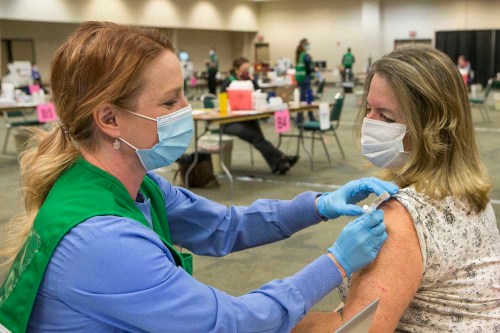Flu making a strong comeback as pandemic safeguards are discarded
Published 1:00 pm Wednesday, September 21, 2022

- Karla Toms, a registered nurse with St. Charles Health System, administers a vaccine in the arm of Suzi Smith, of Bend, during a COVID-19 vaccination clinic in January 2021 at the Deschutes County Fair & Expo Center in Redmond.
PORTLAND — After more than two years of record lows, influenza — the flu — is making a comeback in Oregon, state researchers say.
The latest COVID-19 report from Oregon Health & Science University, released on Friday, Sept. 16, showed the omicron variant of the virus remained active but controlled.
But it’s likely that the drop-off in masking and social distancing as the pandemic has moved into a less virulent stage has allowed for a resurgence of influenza. That combined with what’s likely lower levels of vaccinations for the flu have the OHSU forecasters saying the flu will likely put more people in the hospital this autumn than COVID-19.
“Your flu vaccine is extremely important this year — and certainly more than it has been in the last two years when we had virtually no flu that was circulating,” said Peter Graven, director of the OHSU Office of Advanced Analytics, in an e-mail. “The flu is probably going to be at least as important this year as COVID.”
The new forecast shows a steady decline of severe COVID-19 cases in Oregon, with 253 people in hospitals around the state testing positive for the virus as of Sept. 14.
OHSU projects those totals will continue to fall through the end of October before likely turning back up in November as immunity from earlier vaccinations and exposure wanes and gatherings are more frequently indoors in colder weather, where the virus can infect people who are together in enclosed settings.
OHSU researchers have been tracking flu rates in the southern hemisphere, where the seasons are reversed. Respiratory illnesses, such as flu and COVID-19 tend to spread faster during autumn and winter.
Graven cited relatively high rates of influenza starting early in some areas of the southern hemisphere, where “flu season” peaks between April and October.
A favorable side effect of the public wearing masks, limiting who they met with indoors, and other social distancing efforts during the pandemic is that the same safeguards worked against spread of the flu.
Dr. Dawn Nolt, professor of pediatric infectious diseases at the OHSU School of Medicine, said the state is experiencing the downside of those pandemic safeguards now. As people have been more willing to endure a possible exposure to the highly contagious but less debilitating omicron variants of COVID-19 this year, the flu can hit harder because of the lack of exposure that gives the body practice in fighting off influenza.
“In normal years, lots of people are exposed to the flu, which provides a natural boost to their immune response,” she said. “We haven’t seen much flu at all in the past three years. That makes it really important to get yourself vaccinated against flu this season.”
Flu vaccines are currently available at pharmacies and health care centers throughout the state. People who are getting the new bivalent booster targeting the currently dominant BA.4 and BA.5 omicron variants of COVID-19 should also get a flu shot, health officials said.
OHSU reported Sept. 16 the number of COVID-19 cases is far below the 1,178 people hospitalized with COVID-19 during the peak of the delta wave on Sept. 1, 2021.
The Johns Hopkins Coronavirus Resource Center reported Sept. 16 that 611,307,309 confirmed cases of COVID-19 have been reported worldwide since the virus first appeared in China at the very end of 2019. Global deaths from COVID-19 now stand at 6,524,660.
The United States has recorded 95,629,616 cases and 1,053,164 deaths. Oregon has reported 885,963 cases and 8,492 deaths.
Over the course of the pandemic, Oregon has had the second lowest per capita rate of infections in the United States, trailing only Maryland, according to an analysis by the New York Times. The state has had the eighth lowest death rate.









